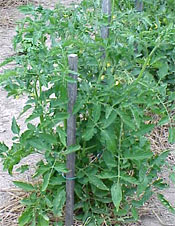
Tomato vines that ramble over the ground are much more likely to suffer damage from slugs, and the fruits are prone to rot wherever they touch the ground. Keeping fruit off the ground and exposed to the sun enhances ripening, and is especially important where the growing season is brief. There are a number of ways to accomplish this. You can use stakes or cages to support the plants, for example, or train the tomato vines to a trellis or up a string.
It's helpful to understand how different types of tomatoes grow, so you can match the training system to the type of tomato.
Indeterminate vs. Determinate
You've probably seen the terms indeterminate and determinate used to describe tomato varieties. Below is a chart explaining the differences. Note that these are generalizations, and that varieties will vary in the degree they exhibit these characteristics.
Indeterminate
Determinate
Tomatoes form shoots or "suckers" in the crotch where a leaf meets a stem. If you let a sucker grow, it simply becomes another big stem with its own blossoms, fruits and suckers.
Pruning tomatoes involves pinching off these suckers to limit the number of stems on the plant.
Stakes
At planting time, insert a sturdy stake about 6" from the stem. As the plant grows, use soft plant ties or strips of fabric to tie the stem to the stake at regular intervals.
For determinate varieties, a 4-foot stake is adequate; for taller indeterminate varieties, use a stake that's at least 6 feet in length. Drive the stake about a foot into the soil.
Prune staked plants to just one or two main stems by removing suckers.
Cages
Cages are one of the simplest and most popular training systems. Cages are available in a number of different styles and sizes. You can also construct your own using wire fencing. Note that cages should be anchored to the ground with stakes to keep top-heavy plants from toppling.
Small commercial cages are adequate for determinate tomatoes, but you'll want a cage that stands at least 4 feet tall for indeterminates.
You can either prune plants to just a few main stems, or allow the plants to branch freely, tucking wayward stems back into the supports on the cage.
Trellises
You can create a sturdy trellis using livestock fencing or concrete reinforcing wire supported at regular intervals by metal fenceposts.
This is a good method if you plan to grow a number of indeterminate plants. You can train the plants to a single stem, or allow a few side branches to develop. Use soft plant ties or strips of fabric to ties the stems to the wire mesh.
Wire Tunnels (or Quonsets)
Use concrete-reinforcing wire or fencing to create a tunnel over a row of tomato plants. The wire will support the stems as they grow up and through the mesh. These tunnels are excellent for determinate varieties. With indeterminate varieties, just drape any branches that creep into the row back over the top. The six-inch mesh is big enough to make picking simple.
Choose a material with wires spaced 3 by 6 inches. A piece of wire six feet across will make an arch about 18 inches tall across a 30-inch-wide bed. (To span a wider bed, the wire may need support in the center to carry the weight of a crop of tomatoes.) If you cut out the horizontal pieces along the bottom edge, you create three-inch-long pins to push into the soil.
You can use these quonsets for cucumbers, squash and melons, as well as peppers, rangy varieties of bush beans and cut flowers.
Pruning Tops of Plants
You can pinch off the tip of the main stem above the top blossom of indeterminate tomato varieties to keep a flourishing plant from getting any taller. This type of pruning can be helpful when a plant is outgrowing its support, or toward the end of the growing season when a taller plant won't help much in terms of increased production. At that point, you'd prefer to see the plant put its energy into ripening the tomatoes already on the vine.